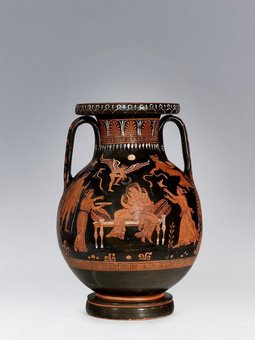Sept. 29, 2010 – April 3, 2011
Naples – Italy
 How did women live 2500 years ago in the Mediterranean regions? An answer to this question is provided by a splendid exhibition, now open in Naples. It features thirty vases made between the 5th and the 3rd century b.C. and found in Ruvo di Puglia, an area in the South of Italy that at the time was part of the Great Greece.
How did women live 2500 years ago in the Mediterranean regions? An answer to this question is provided by a splendid exhibition, now open in Naples. It features thirty vases made between the 5th and the 3rd century b.C. and found in Ruvo di Puglia, an area in the South of Italy that at the time was part of the Great Greece.
Using the typical red figure technique, the pottery makers painted on their vases scenes from women’s daily life.
Queens in their own house, they spent there most of their time. They are depicted while busy in their homely chores, weaving colorful fabrics for their clothes, nursing their children, leaving their bedrooms to meet their husbands in the thalamos, the common bedroom. Outside their house, wedding celebrations and death rituals were women’s most important public activities.
 The vases also show the “other” women, the courtesans, concentrated in their beauty rituals. They are depicted naked, symbolizing the physical pleasure, although they were required to show their talents in arts, too.
The vases also show the “other” women, the courtesans, concentrated in their beauty rituals. They are depicted naked, symbolizing the physical pleasure, although they were required to show their talents in arts, too.
As key characters of myths and legends they were among the favourite subjects of the artists. Two vases on display show them in the role of Maenads, the female followers of Dionysus, and Amazons, proud and bold warriors who “used” men only to prevent their race from dying out.
 The exhibition represents a unique visual description of the life of women, from men’s point of view. It could not be otherwise, in fact, because the role of women in the community was very conventional.
The exhibition represents a unique visual description of the life of women, from men’s point of view. It could not be otherwise, in fact, because the role of women in the community was very conventional.
The vases are part of a one of the largest and most important collections of Greek and Greater Greek ceramics of the world. More than 500 pieces that will be exhibited in small groups in the next few years. Each group will be a chapter of a visual story, named “Time in the Antiquity. Pages of archeology and culture”: time for love, work, religion, death, myth. And men’s hours of course.
Le Ore della Donna
Galleria di Palazzo Zevallos Stigliano
Via Toledo 185, Napoli
Opening hours: Tuesday to Sunday from 10 am to 6 pm.
Email: info@palazzozevallos.com
